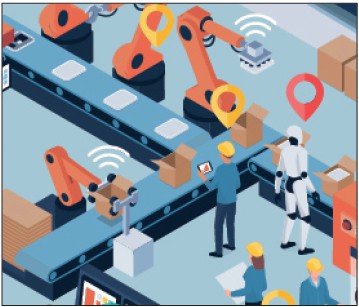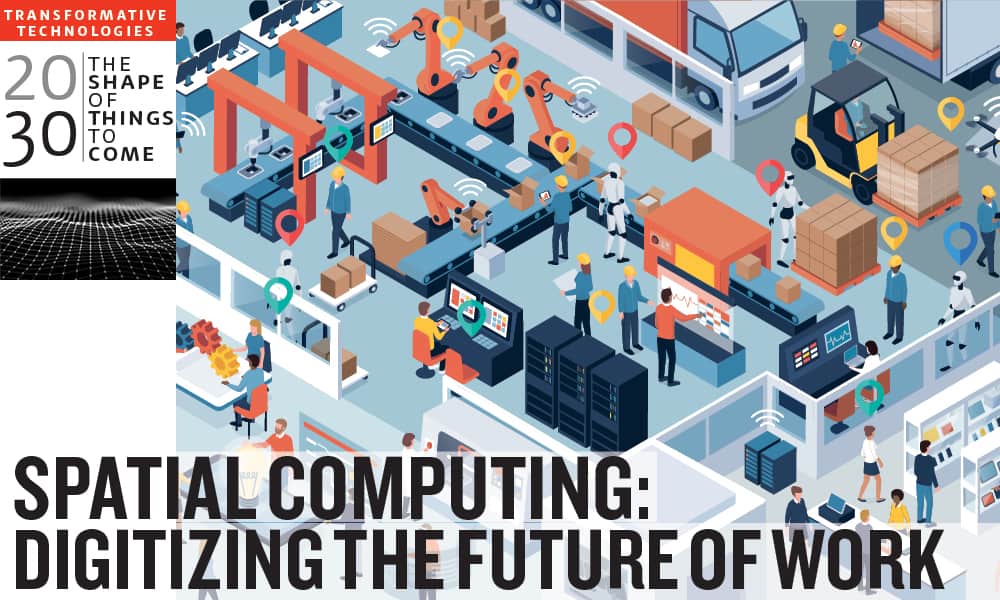Spatial Computing: Digitizing the Future of Work
By 2030, spatial computing applications that precisely locate and map 3D movements to improve operations and maximize the multiple interactions between humans, machines, objects, and working environments will become ubiquitous.
By Steve Dertien & Will Hastings
Spatial computing is the digitization of spatial relationships between machines, people, objects, and environments to identify both their precise location and their movement within a 3D space to enable and optimize their operations and interactions.
It describes a class of applications that most are already familiar with in their personal lives. If you’ve used GPS navigation or activated Tesla’s autopilot mode, you’ve already enjoyed some of the benefits of spatial computing.
Human and Machine Interaction
In today’s world, work increasingly gets done through a combination of human and machine inputs. McKinsey estimates that for 60% of occupations, 30% of the tasks involved are automatable. In the decade ahead, automation and human labor will play increasingly complementary roles.
That can be good, but also has risks; the safeguarding methods used for decades to protect workers are often insufficient for this new environment and could be impediments to the future of human and machine collaboration. What is missing today is how to optimally utilize machines and humans in a clearly defined physical space to get work done. For manufacturers, emerging spatial computing technologies offer unique opportunities to address this challenge and unlock the next step change in productivity.
With the rapid advances in machine learning, computer vision, wireless communication, satellite positioning systems, and other technologies, along with the increasing ubiquity of cloud computing, industry is at a tipping point for the development of spatial computing applications in the decade ahead. In the factory, the warehouse, or out in the field, by 2030 the comprehensive capture of motion and precise location will reveal insights into the way machines, people, and processes work and interact with each other and their surroundings. Future manufacturers will leverage this new understanding to dramatically improve the efficiency and safety of operations by expanding the scope of IIoT initiatives, empowering front-line workers, and optimizing their industrial environments.

“With a shared understanding of the space and happenings around them, the actions of people and machines will be harmonious.”
Expanding the Vision of IIoT
Over the past decade manufacturers have reached new levels of efficiency through Industrial IoT initiatives. These connected operations are already creating and leveraging vast amounts of data to maximize revenue, reduce cost, and improve quality. What IIoT has done for manufacturing cannot be understated, but it is still unable to provide a fully comprehensive view of all operations as it currently lacks important spatial information.
Essentially, traditional IIoT is blind to its surroundings. In choosing what sensors to install and what machines to connect, adopters of IIoT define the boundaries of their own digital perception. These boundaries can result in enormous gaps of knowledge between the digital representation of an operation and its physical execution in a 3D environment.
Companies commonly rely on people to bridge these gaps. It is often the people on the factory floor who identify when a missing bolt is responsible for abnormal vibration data, or when a dropped pallet at one end of the factory impacts the uptime of a line at the other end. Despite their unmatched ability to discover and react to changes in their environment, to rely on people for this role comes with unavoidable challenges. Their perception is limited to their immediate surroundings, their knowledge is difficult to transfer, and their ability to input and retrieve digital information is limited by modern human-machine interfaces. For many people, making connections between seemingly disparate events either happens by chance, or is painstakingly slow.
Spatial computing promises to resolve these challenges by digitizing the discovery process and providing IIoT with “eyes on the ground”. With the discovery process digitized, analytics can be applied to correlate all activities, not just the ones that have been connected. Insights gained from this process can be acted on quickly to improve operations in, or near, real-time. With spatial computing adding motion awareness to the analytical mix, manufacturers in 2030 will be able to augment their IIoT capabilities to move beyond the intermittent optimization of individual processes, to the continuous optimization of entire factories.
Connecting Workers to the Digital Workflow
It may seem that spatial computing threatens the value proposition of the frontline worker, but this couldn’t be further from the truth. Spatial computing is a means to address the challenges faced by frontline workers by digitizing their movement and connecting them as a consumer and provider to the digital ecosystem that surrounds them.

“The adoption of spatial computing in manufacturing will happen much quicker than you might think.”
Motion capture has long been used by clinical medicine to analyze biomechanics for health reasons and by high-performance athletes to perfect their tennis serve or golf drive. With spatial computing entering the industrial setting, the same type of analysis can be applied to workers to examine their motion and synthesize individually tailored best practices. These industrial athletes will be empowered with personalized processes suited to their unique skills and physical attributes and optimized for safety and efficiency. Going one giant step further, companies will be able to leverage augmented reality to deliver the insights gained through spatial computing in time, and in a spatial context, for each worker.
From operators to technicians and floor managers, the incorporation of people’s action and intelligence into the real-time digital workflow of manufacturing operations will be imperative for training and upskilling workers, improving labor performance, increasing safety, and reducing planned and unplanned downtime. The workforce of 2030, digitally native millennials and younger generations, will thrive in this advanced, technology driven environment as it reflects the high expectations of the technologies they will already use in their normal lives.
Improving Collaboration & Optimizing Environments
By 2030, the cutting-edge applications of spatial computing now being adopted today will be components of much broader spatial computing initiatives. With a shared understanding of the space and happenings around them, the actions of people and machines will be harmonious. Operators will use gesture control to direct the motion of machines. Machines will adjust their actions to account for the movements of people and products. Each will be aware of the goals and intent of the other through a shared perception of digital and spatial information.
In this vision, it’s not just the operations that are optimized, but the environment as well. For the first time, industrial engineers will have a complete and persistent view of the interaction of materials, people, and processes. This comprehensive knowledge will provide continuous feedback for the improvement of factory or warehouse layouts to resolve inefficiencies of time, motion, and the use of space. With spatial computing, each industrial environment will be as engineered, monitored, analyzed, and optimized as the processes conducted within it.
More Science than Fiction
The adoption of spatial computing in manufacturing will happen much quicker than you might think. Already spatial computing is permeating our daily lives and will soon play a larger role with the continued advances in autonomous vehicles and the incorporation of spatial sensing (LiDAR) into next generation smartphones. The world is about to witness an explosion in applications, expertise, and opportunity in this domain. In the industrial world, companies with established IIoT and Augmented Reality programs will find the incorporation of spatial computing a logical and transformative next step in their digital transformation journey. M
FOOTNOTES
1 Niall McCarthy,” Rise of the Machines: The Countries with the Highest Density of Robot Workers,” Forbes, Sep 28, 2020, https://www.forbes.com/sites/niallmccarthy/2020/09/28/rise-of-the-machines-the-countries-with-the-highest-density-of-robot-workers-infographic/amp
2 Ibid.
3 Emil Protalinski, “Boston Dynamics CEO talks profitability and the company’s next robots,” Venture Beat, Sep 14, 2020, https://venturebeat.com/2020/09/14/boston-dynamics-ceo-profitability-roadmap-next-robots/
4 Manufacturing Leadership Council, “Vision 2020: The Factory of the Future,” 2017. https://www.mljournal-digital.com/meleadershipjournal/ february_2017? pg=25#pg25
5 Art Markman, “How You Define the Problem Determines Whether You Solve It,” Harvard Business Review, June 6, 2017, https://hbr-org.cdn.ampproject.org/c/s/hbr.org/amp/2017/06/how-you-define-the-problem-determines-whether-you-solve-it
6 Manufacturing Leadership Council, “Vision 2020: The Factory of the Future,” 2017.
7 Niall McCarthy,” Rise of the Machines: The Countries with the Highest Density of Robot Workers,” Forbes, Sep 28, 2020, https://www.forbes.com/sites/niallmccarthy/2020/09/28/rise-of-the-machines-the-countries-with-the-highest-density-of-robot-workers-infographic/amp/[/et_pb_text][/et_pb_column][/et_pb_row][/et_pb_section]
